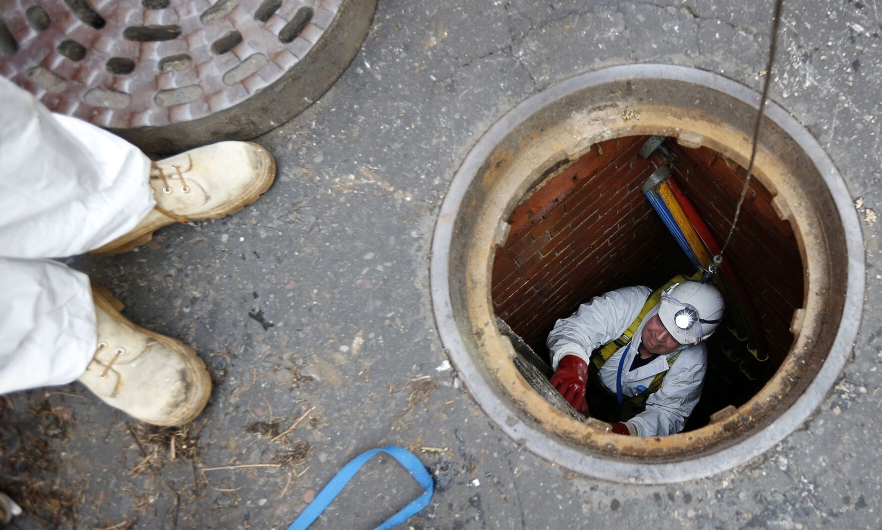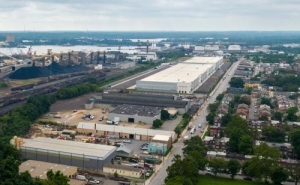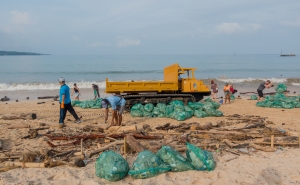Fatbergs: Menaces to Public Works and Public Health
Fatbergs are a potent symbol of how we’ve come to take our aging water infrastructure systems for granted.

ADRIAN DENNIS/AFP via Getty Images
When you wash your dishes or flush the toilet, all the waste disappears down the drain. But that’s just the start of its journey.
From your home’s pipes, that waste and water flow into the sewers, where our underground infrastructure diverts it to wastewater treatment plants.
When it works as intended, water infrastructure is one of many public health achievements that is invisible in our day-to-day lives. This “out of sight, out of mind” mentality makes it easy for people to take these complex systems for granted.
Maintaining healthy water infrastructure isn’t just the responsibility of local governments or public works employees; we all play a part in keeping things flowing. So what happens when you flush things you shouldn’t—oil, food scraps, or so-called flushable wipes? It causes a nightmare for utility workers and public health. Enter: The Fatberg.
What is a fatberg?
A fatberg is typically made out of fat, oil, and grease—which do not break down in the sewer system—combined with other things that shouldn’t have been flushed, like sanitary products and personal wipes. The fat, oil, and grease harden and stick all these non-biodegradable objects together, causing an immovable clog: a fatberg.
The problem is compounded in older cities with open drains intended for rainwater. These can end up collecting litter and other items that contribute to major blockages. In 2021, a fatberg in Birmingham, England—possibly the largest ever recorded—measured three feet high and more than half a mile in length. And in 2017, a fatberg in Baltimore caused a sewer overflow to discharge 1.2 million gallons into the local Jones Falls waterway.
How fatbergs cause backups
While much of our water infrastructure is hidden beneath our feet, the first evidence of a fatberg often appears when basement toilets begin to back up. Sewer systems are gravity-fed, so “if there are blockages, often the really nasty wastewater finds its way up to the lowest outlets—and that’s often basement toilets,” explains Natalie Exum, PhD ’16, an assistant scientist in Environmental Health and Engineering.
Because this wastewater is untreated and contains human waste, this type of backup creates a hazardous environment that can spread disease. And it’s not only a concern for private homes; backups can happen anywhere there’s plumbing—apartment complexes, businesses, restaurants, and even health care facilities—where there is greater risk of exposure to this hazardous material.
How to remove a fatberg
These underground, hard-as-concrete masses require manual removal. Sanitation workers use high-powered water jets, saws, and pick-axes to break fatbergs apart into smaller chunks that can then be removed from the sewer, either by hand or using an industrial vacuum. Clearing a single blockage can take hundreds of hours. A 40-ton fatberg in London took three weeks to clear with eight people working nine hours a day, and others have taken even longer.
According to the National Association of Clean Water Agencies, products such as wipes, that should not be flushed but often are, end up costing billions of dollars in maintenance and repair costs. They estimate that wipes, whether or not they’re marked as flushable, cost U.S. utilities $441 million a year in additional operating costs.
“You get into this vicious cycle,” Exum explains. Extracting fatbergs from centralized infrastructure can involve shutting down roads and digging up streets. “That costs a ton of the city budget and then you’re having to slash the parts of your budget that are more proactive.”
Fatbergs stress an overstressed system
Aging infrastructure and sewer systems are especially vulnerable to fatbergs. Unfortunately, this is the case in many cities around the world.
In Baltimore, for example, many pipes predate 1904, which is when the sanitary sewer and stormwater systems were first separated. “These [older] pipes … are simply not big enough to carry the amount of storm water or wastewater that's supposed to be moving through them,” explains Alice Volpitta, Baltimore Harbor Waterkeeper for Blue Water Baltimore, in a special World Water Day episode of Public Health On Call.
In the case of the Baltimore fatberg in 2017, the pipe that became clogged was only 24” wide and over 100 years old. When fat, oil, and grease combine with other items that should not be in the system, “they create this impassable object within a pipe that's already too small for its designed capacity,” says Volpitta.
What you can do to prevent fatbergs
Fatbergs are created through a snowball effect, exacerbated by each individual non-flushable item that goes into the sewer system. We can all help to keep things flowing by simply not putting anything down the drain—in a sink, toilet, tub, or street drain—that doesn’t belong or won’t break down.
It’s essential for everyone to understand how important their personal actions are to maintaining a system most of us don’t get to see up close, Volpitta says. She imagines the difference it might make if more people could see the items that make it to our wastewater treatment plants: tampons, pads, diapers, dental floss, clothes, and even plastic bags.
In addition to taking personal responsibility for what we put down the drain, Volpitta says people can help by reporting sewage overflows and blockages, illegal dumping, and pollution to their local citizens’ hotline (by dialing 3-1-1 in many U.S. cities).
So what can we safely put down the drain?
Only liquids you can drink should go down your kitchen sink. Garbage disposals can help break up food to keep it from clogging your drain, but it’s safer—and better for the environment—to compost your food waste instead. Fats, cooking oil, and grease should be disposed of in the trash.
“In a perfect world, the less that goes into the pipes the better. It all ends up in the same place,” says Exum. “Even if your garbage disposal can handle something, that doesn't mean it should."
The only things that should be flushed down your toilet are toilet paper and human waste. Everything else—paper towels, tissues, condoms, hygiene products—should go in the trash. That includes wipes. “Flushable wipes are not flushable,” Exum stresses. They are often made of cotton or synthetic fabrics that do not break down quickly like toilet paper.
Remember: Just because something might not clog your home’s drain—though there’s a good chance it will—doesn’t mean it won’t clog your community’s sewer system.
Public Health On Call
This article was adapted from the March 22 episode of Public Health On Call Podcast.
Aliza Rosen is a digital content strategist in the Office of External Affairs at the Johns Hopkins Bloomberg School of Public Health.




